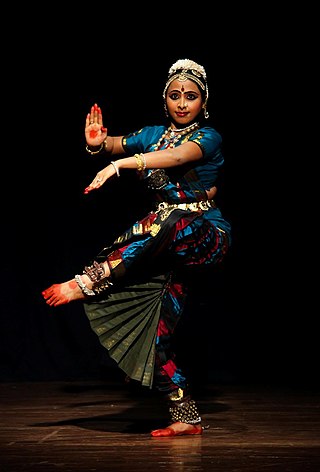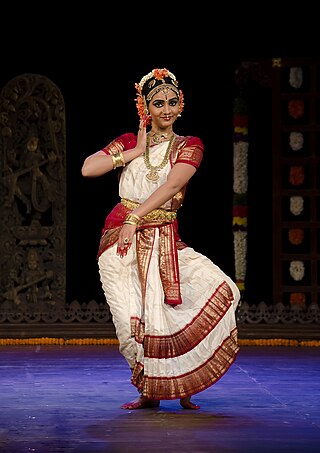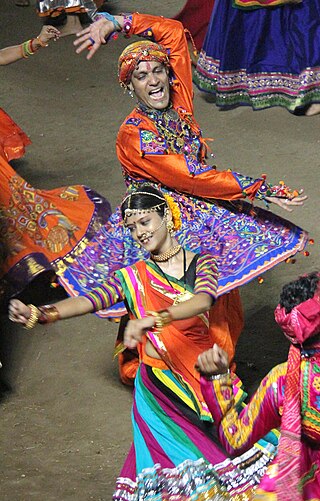Related Research Articles

Bharatanatyam is an Indian classical dance form that originated in Tamil Nadu, India. It is a classical dance form recognized by the Sangeet Natak Akademi, and expresses South Indian religious themes and spiritual ideas of Hinduism and Jainism.

Kuchipudi is one of the eight major Indian classical dances. It originates from a village named Kuchipudi in the Indian state of Andhra Pradesh. Kuchipudi is a dance-drama performance, with its roots in the ancient Hindu Sanskrit text of Natya Shastra. It developed as a religious art linked to traveling bards, temples and spiritual beliefs, like all major classical dances of India.

Odissi, also referred to as Orissi in old literature, is a major ancient Indian classical dance that originated in the temples of Odisha – an eastern coastal state of India. Odissi, in its history, was performed predominantly by women, and expressed religious stories and spiritual ideas, particularly of Vaishnavism through songs written and composed according to the ragas & talas of Odissi music by ancient poets of the state. Odissi performances have also expressed ideas of other traditions such as those related to Hindu deities Shiva and Surya, as well as Hindu goddesses (Shaktism).

Indian classical dance, or Shastriya Nritya, is an umbrella term for different regionally-specific Indian classical dance traditions, rooted in predominantly Hindu musical theatre performance, the theory and practice of which can be traced to the Sanskrit text Natya Shastra. The number of Indian classical dance styles ranges from six to eight to twelve, or more, depending on the source and scholar; the main organisation for Indian arts preservation, the Sangeet Natak Academy recognizes eight: Bharatanatyam, Kathak, Kuchipudi, Odissi, Kathakali, Sattriya, Manipuri and Mohiniyattam. Additionally, the Indian Ministry of Culture includes Chhau in its list, recognising nine total styles. Scholars such as Drid Williams add Chhau, Yakshagana and Bhagavata Mela to the list. Each dance tradition originates and comes from a different state and/or region of India; for example, Bharatanatyam is from Tamil Nadu in the south of India, Odissi is from the east coast state of Odisha, and Manipuri is from the northeastern state of Manipur. The music associated with these different dance performances consists many compositions in Hindi, Malayalam, Meitei (Manipuri), Sanskrit, Tamil, Odia, Telugu, Assamese, and many other Indian-Subcontinent languages; they represent a unity of core ideas and a diversity of styles, costumes, and expression.

Garba is a form of Gujarati dance which originates from the state of Gujarat, India. The name is derived from the Sanskrit term Garbha. Many traditional garbas are performed around a centrally lit lamp or a picture or statue of the Hindu goddess Durga. Traditionally, it is performed during the nine-day Hindu festival Navaratri. Either the lamp or an image of the Goddess, Durga is placed in the middle of concentric rings as an object of veneration.

Dance in India comprises numerous styles of dances, generally classified as classical or folk. As with other aspects of Indian culture, different forms of dances originated in different parts of India, developed according to the local traditions and also imbibed elements from other parts of the country.

The nautch was a popular court dance performed by girls in later Mughal and colonial India. The word "nautch" was a British corruption of Nachna, the Hindi verb to dance. The culture of the performing art of the nautch rose to prominence during the later period of Mughal Empire and the rule of the East India Company.

Tanjore Balasaraswati, also known as Balasaraswati, was an Indian dancer, and her rendering of Bharatanatyam, a classical dance style originated in the South Indian state of Tamil Nadu, made this style of dancing well known in different parts of India and many parts of the world.

Sanjukta Panigrahi was a dancer from India, who was the foremost exponent of Indian classical dance Odissi. Sanjukta was the first Odia woman to embrace this ancient classical dance at an early age and ensure its grand revival.

Sitara Devi was an Indian dancer of the classical Kathak style of dancing, a singer, and an actress. She was the recipient of several awards and accolades, and performed at several prestigious venues in India and abroad; including the Royal Albert Hall, London (1967) and at the Carnegie Hall, New York (1976).

Sangeet Natak Akademi is the national level academy for performing arts set up by the Government of India.

Prabhu Deva is an Indian dance choreographer, film director, producer and actor who has worked predominantly in Tamil, Hindi and Telugu language films. In a career spanning 32 years, he has performed and designed dancing styles and has garnered two National Film Awards for Best Choreography. In 2019, he was awarded the Padma Shri for his contributions to dance.
GRID-Arendal is a United Nations Environment Programme partner, located in Arendal, Norway. The Norwegian government created AGRID-Arendal 35 years ago.

Indrani Rahman was an Indian classical dancer of Bharata Natyam, Kuchipudi, Kathakali, Odissi and first beauty pageant titleholder. she popularised in the west and later settled in New York in 1976.
Darshana Jhaveri, the youngest of the four Jhaveri sisters, is a leading Indian exponent of Manipuri dance, an Indian classical dance form. She is a disciple of Guru Bipin Singh, and started performing on stage in 1958 along with her sisters. She is one of the founders of the Manipuri Nartanalaya in 1972, which popularized Manipuri dance in India, and is currently headed by her, with centres at Mumbai, Kolkata and Imphal.

Folk dances of Assam include the Bihu and the Bagurumba, the Bhortal, the Ojapali dance. Assam is home to many groups: Muslim, Indo-Aryan, Rabha, Bodo, Dimasa, Karbi, Mising, Sonowal Kacharis, Mishmi and Tiwa (Lalung) etc. These cultures come together to create an Assamese culture. Residents of the state of Assam are known as "Axomiya" (Assamese). Most tribes have their own language, although Assamese is the primary language of the state.
Annick Chaymotty, known by the stage name Kumari Devayani, is an Indian dancer who performs in the classical Indian dance style Bharatanatyam. She has performed in India as well as in festivals and concert halls in the UK, France, Germany, Spain, Italy, Greece, Portugal, the Scandinavian countries, Estonia, and South Korea. Devayānī is an empanelled artist with the Indian Council for Cultural Relations. In 2009, she was awarded the Padma Shri.

Gaddam Padmaja Reddy is an Indian Kuchipudi exponent and music teacher. She performs ballets on mythological themes and contemporary social issues. She choreographed Kakatiyam, a Kuchipudi visual dance form. She was conferred with Kala Ratna in 2006, India's highest art award–Sangeet Natak Akademi Award in 2015 and Padma Shri, India's fourth highest civilian award, in the field of art for 2022.
References
- ↑ "Grida Dance in India". www.india9.com.